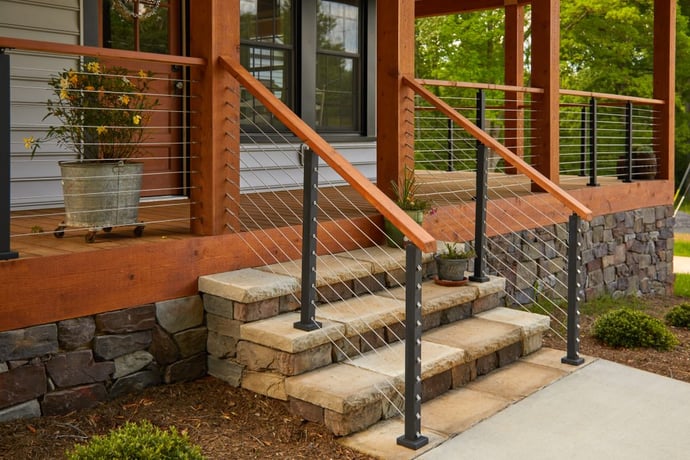
When it comes to creating a modern and sophisticated living space, homeowners and designers are always looking for innovative ways to incorporate striking architectural elements. One such feature that has been growing in popularity is floating stairs, combined with custom Floating Stairs. These design features add a sense of elegance, openness, and style to any home or commercial property. This article explores how floating stairs and custom railings work together to enhance the aesthetic and functionality of a space, offering a perfect blend of beauty and practicality. What Are Floating Stairs? Floating stairs, often referred to as cantilevered stairs, are a type of staircase that appears to “float” without visible support. The treads of the stairs seem to hover in mid-air, with minimal or no support visible from the side, giving them a sleek and modern appearance. Floating stairs can be made from various materials, including wood, metal, or glass, and are often designed to fit the specific aesthetic of a home or commercial space. The design creates a sense of openness, making a room feel larger and more airy while adding a striking architectural element that serves as a focal point in any room. The Benefits of Floating Stairs in Modern Architecture The main appeal of floating stairs lies in their minimalist and contemporary design. The absence of bulky support structures allows for unobstructed sightlines, contributing to a more open and spacious feeling in the room. This is particularly beneficial in homes with open floor plans or those looking to maximize natural light and airflow. The aesthetic of floating stairs also complements a wide variety of design styles, from ultra-modern spaces to industrial lofts. Additionally, the sleek lines and simple design of Custom Railings and stairs make them a versatile choice that can be customized to fit different preferences, ensuring they seamlessly blend into any environment. Custom Railings: A Stylish Complement to Floating Stairs Custom railings are an essential component when designing a staircase, particularly when paired with floating stairs. These railings serve not only as a safety feature but also as a design element that enhances the overall look of the stairs. Custom railings can be designed to match the specific style of the home or building, from sleek, contemporary lines to more ornate, traditional designs. The use of materials like stainless steel, glass, wood, or even cable systems allows for endless possibilities when it comes to creating a unique and stylish look. Custom railings can be made to fit the dimensions and angles of any floating stair design, ensuring that they not only provide safety but also complement the overall aesthetic. How Floating Stairs and Custom Railings Work Together When floating stairs and custom railings are combined, the result is a visually striking and functional design element that elevates the entire space. The clean, open look of floating stairs is complemented by railings that provide both safety and style. Custom railings can be designed to complement the floating stairs’ materials, such as glass railings paired with wooden treads or stainless steel cables with metal steps. The seamless integration of these two design features creates a cohesive, modern look that adds sophistication to the space. Whether the goal is to achieve a minimalist or a more ornate style, the combination of floating stairs and custom railings offers a wide range of design possibilities. Design Flexibility with Floating Stairs and Custom Railings One of the key advantages of floating stairs and custom railings is the design flexibility they offer. Both elements can be highly customized to meet the specific needs and preferences of the homeowner or designer. Floating stairs can be tailored in terms of materials, shape, and size, allowing them to fit seamlessly into any space. Custom railings can be designed to match the color scheme, style, and material choices of the surrounding area. For example, sleek glass railings can create a modern, transparent barrier, while wood railings can add warmth and texture. This flexibility ensures that floating stairs and custom railings can be incorporated into a wide variety of interior styles, from contemporary to traditional, industrial, or even rustic designs. Safety Considerations for Floating Stairs and Custom Railings While floating stairs and custom railings are undeniably stylish, safety is an important consideration when designing these features. Floating stairs need to be carefully engineered to ensure they are stable and secure. Proper support must be provided, usually through concealed steel brackets or cantilevered structures, to ensure the stairs remain safe to use. Custom railings, too, must adhere to building codes and safety standards. For example, railings must be of sufficient height and strength to prevent falls, especially in homes with children or elderly residents. Additionally, the spacing between the rungs or cables in custom railings should be designed with safety in mind to avoid any potential hazards. When properly designed and installed, both floating stairs and custom railings are not only beautiful but also safe and secure. Installation Process of Floating Stairs and Custom Railings The installation of floating stairs and custom railings requires skilled craftsmanship and precise engineering. Floating stairs often involve custom design work, as the treads need to be properly supported and balanced. The support structure for floating stairs can be concealed within the walls or integrated into the staircase itself, ensuring that the floating effect is achieved. Similarly, custom railings need to be installed with attention to detail to ensure they are both functional and visually appealing. The installation process involves precise measurements, secure mounting, and careful integration of materials to create a seamless and cohesive design. Given the complexity of these features, it is essential to hire experienced professionals who specialize in custom staircases and railings to ensure the final result is both beautiful and safe. Maintenance and Durability of Floating Stairs and Custom Railings Maintaining floating stairs and custom railings is relatively simple, especially when high-quality materials are used. Floating stairs made from durable materials such as steel, wood, or glass are long-lasting and require minimal upkeep. However, periodic inspections are recommended to ensure that the structural supports are secure and that no damage has occurred. Custom railings, whether made from wood, metal, or glass, should be regularly checked for wear and tear, such as loose fittings or rusting. Cleaning is also an important aspect of maintenance. For example, wooden railings may require occasional refinishing, while glass railings can be cleaned with glass cleaner to maintain their clarity. Overall, both floating stairs and custom railings are low-maintenance, long-lasting features that add timeless value to any home. Conclusion Floating stairs and custom railings are key elements in modern architectural design, offering both aesthetic appeal and functional benefits. Floating stairs create a sense of openness and elegance, while custom railings provide safety and a personalized design element. Together, these features create a cohesive, sophisticated look that can transform any space into a stylish and functional environment. With their flexibility in design and customization options, floating stairs and custom railings are perfect for homeowners and designers seeking to create a unique, modern, and visually striking space. By carefully considering design, safety, and installation, these features can be seamlessly incorporated into a variety of settings, ensuring that they continue to add value and beauty for years to come.







